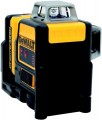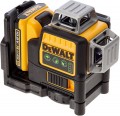Measurement range
The range at which the device remains fully operational without the use of additional receivers (see below); in other words, the radius of its action without auxiliary devices.
In some models, a range may be specified that shows the minimum (
3 cm,
5 cm) and maximum measurement ranges. But in most cases, only the maximum value is indicated.
The specific meaning of this parameter is determined by the type of instrument (see above). So, for optical levels, the measurement range is the greatest distance at which the operator can normally see the divisions of a standard leveling staff. For laser levels, this parameter determines the distance from the device to the surface on which the mark is projected, at which this projection will be easily visible to the naked eye; and in rangefinders we are talking about the greatest distance that can be measured. Typically, the measurement range is indicated for ideal conditions - in particular, in the absence of impurities in the air; in practice, it may be less due to dust, fog, or vice versa, bright sunlight "overlapping" the mark. At the same time, tools of the same type can be compared according to this characteristic.
Note that it is worth choosing a device according to the range of action, taking into account the features of the tasks that are planned to be solved with its help: after all, a large measurement range usually significa
...ntly affects the dimensions, weight, power consumption and price, but it is far from always required. For example, it hardly makes sense to look for a powerful laser level at 30-40 m if you need a device for finishing work in standard apartments.Measurement range (with receiver)
The longest measurement range provided by a laser level (see “Type”) when using a special receiver with a photocell.
Thanks to its sensitivity, such a receiver is able to respond even to a weak laser beam, the mark from which is no longer visible to the naked eye; At the same time, the area of the photocell is quite large, and special indicators make it possible to determine the exact position of the mark. Among other things, this significantly expands the range of action of the level - the measurement range with a receiver is usually several times greater than without it. On the other hand, such equipment inevitably affects the overall cost of the device; and in some models the receiver
is not included in the package at all; it must be purchased separately. However, the second option also has its advantages: you do not need to immediately pay for an additional accessory, it can be purchased later, when a real need arises, while some models allow you to choose the optimal receiver model from several options at your discretion.
Note that the receiver can be useful not only for increasing range; These points are described in detail in paragraph “Included parts”.
Tripod thread
The standard size of the thread used to mount the level/rangefinder on a tripod (if available). This option can be useful if you already have a surveying tripod that you want to use with the tool.
The most popular options in modern devices are 1/4" and 5/8". It is worth noting that 1/4" is a standard size for
photographic equipment - accordingly, levels with such a thread can be installed even on ordinary
photographic tripods.
Diode emission
The wavelength of the radiation emitted by the LED of the level or rangefinder; this parameter determines primarily the colour of the laser beam. The most widespread in modern models are LEDs with a wavelength of about 635 nm — at a relatively low cost, they provide bright red radiation, giving a well-visible projection. There are also green lasers, usually at 532 nm — the marks from them are even better visible, but such LEDs are quite expensive and rarely used. And radiation with a wave longer than 780 nm belongs to the infrared spectrum. Such a laser is invisible to the naked eye and is poorly suited for leveling, but it can be used in rangefinders — of course, with a viewfinder (see "Type" for more details).
Laser colour
The color of the laser beam emitted by the device.
Red lasers are the most popular in our time: they are relatively inexpensive, while they are quite effective and functional, and also quite noticeable on most surfaces. In turn,
green lasers are better visible to the human eye (with the same emitter power); however, they are noticeably more expensive than red ones, consume more energy and have a shorter service life, and therefore are much less common.
Blue lines are rarely seen in laser instruments. Their competitive advantage over traditional green and red lasers is their high brightness, which ensures excellent visibility of the beams on many surfaces, incl. when doing outdoor work.
In some devices, you can find two types of lasers at once - both red and green. As a rule, these are levels with several projections, where green is used to build planes, and red is used for point projections.
Vertical projections
The number of vertical projections issued by the laser level during operation.
Most modern levels are designed for a strictly defined position when working; accordingly, the
projection is called vertical, carried out from top to bottom relative to the standard position of the device. If there are several such planes, the level can be used for two or even three walls at once — this is useful, for example, for the simultaneous work of several people. At the same time, there are portable devices that can be used in different positions; for them, the main working plane is called vertical, although during operation it can be located both horizontally and at an angle, depending on specific tasks. Also note that the vertical projection can also give a horizontal line — for example, when installing a level on the floor.
Note that the number of projections is calculated not by geometric planes, but by individual laser elements, each of which is responsible for its own “work area”. For example, if the level has two vertical elements located at opposite ends and directed in different directions, they are considered as two projections even if these projections lie in the same plane.
In box
—
holder. Devices for fixing the level / range finder on various surfaces. Such a device differs from a tripod primarily in its small size — within a couple of tens of centimeters. On the other hand, most holders allow you to install the device not only on horizontal, but also on vertical surfaces — for example, walls (and some are exclusively wall-mounted). Anyway, this function greatly expands the installation possibilities.
—
Receiver. laser radiation supplied with the device. This device is usually equipped with laser levels, less often with rangefinders, and it is not required at all for optical instruments. The main purpose of the receiver is situations where the laser mark is not visible to the naked eye — for example, at a long distance or in bright light. More details on the features of its application are described above in the paragraph “Measurement range (with receiver)”.
—
Tripod. Most modern instruments have a standard size thread and can be used with any suitable tripod. On the other hand, a complete tripod is most often specially designed for a certain model and optimally matches it in terms of general characteristics. In addition, this configuration option relieves you of the need to look for and purchase a suitable tripod yourself.
—
Case / case. The main function of these devices is to protect
...the device from bumps, scratches, dirt, temperature changes and other adverse effects; for this, of course, improvised means can also be used, but specialized protection is usually both more convenient and more reliable. In addition, almost all cases and most covers greatly simplify the transportation of the tool — in particular, due to the fact that they can also be used for complete accessories.
— Remote control. Among rangefinders and optical levels, this function is practically not found, because. working with them involves the constant stay of the device in the hands of the operator. But for laser levels that require you to regularly move from the device to the surface to be marked and back, the remote control can be a very useful addition — due to the fact that it minimizes such movements. For example, after marking the "front of work" on the wall according to the projection from the level, you do not have to approach the device to turn it off — just give a command from the remote control. At short distances, the savings in time and effort may not be so obvious, but over large areas, they can become quite noticeable.
